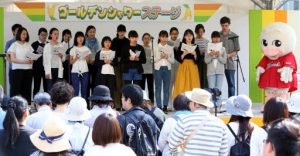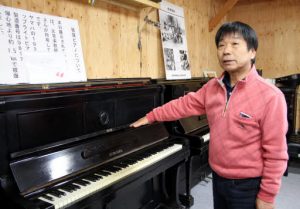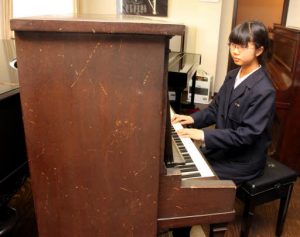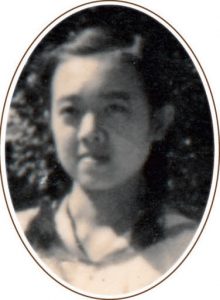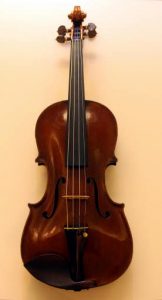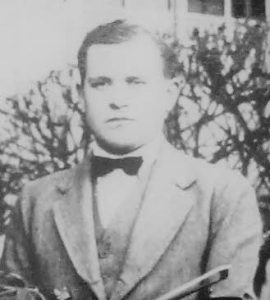Junior writers investigate musical instruments that survived impact of atomic bombing
May 13, 2019
A movement in which people play musical instruments that survived the atomic bombing is now spreading throughout Japan and overseas. The junior writers from the Chugoku Shimbun learned about the A-bomb experiences of the former owners of A-bombed pianos and an A-bombed violin, and interviewed people who have preserved and played the instruments about their wishes for peace. On stage at this year’s Hiroshima Flower Festival, held during Golden Week, the junior writers presented the results of their interviews and sang songs of peace to a recording of music played on an A-bombed piano.
A-bombed pianos appeal for peace in and out of Japan
“A-bombed pianos” are pianos that were exposed to the atomic bomb’s tremendous blast, heat rays, and radiation within an approximately three kilometer radius of the hypocenter. They still bear scars from flying glass fragments and dents to their sides that apparently were caused by the A-bomb blast. In this way, the pianos themselves convey the severe damage wrought by the atomic bomb.
Mitsunori Yagawa, 67, a piano tuner who lives in Asaminami Ward, Hiroshima, has been involved in restoring A-bombed pianos and holding concerts with these instruments since 2001. He now has six A-bombed pianos. The junior writers visited Mr. Yagawa at his studio and asked him to show us his pianos.
Mr. Yagawa started restoring A-bombed pianos after receiving a request from an A-bomb survivor. After listening to the survivor’s life-and-death struggle, Mr. Yagawa thought intently about what he could do to help promote peace. He does the minimum amount of repair possible and leaves the damage done to the body of the piano, to the extent he can, because he believes that the many lingering scars and scratches caused by the atomic bomb can serve as a powerful reminder of the catastrophic consequences of the A-bomb attack.
Mr. Yagawa travels all over Japan, carrying the A-bombed pianos in a truck. He holds about 180 piano concerts a year. In December 2017, when the International Campaign to Abolish Nuclear Weapons (ICAN), a non-governmental organization (NGO), was awarded the Nobel Peace Prize, a world-renowned pianist played one of the A-bombed pianos at a commemorative concert held in Oslo, Norway, enabling the sound of the A-bombed piano to be heard around the world.
Tomie Futakuchi, 70, the head of the general incorporated association HOPE Project and a resident of Saeki Ward, seeks to convey the preciousness of peace through an A-bombed piano that she inherited from the bereaved family of Akiko Kawamoto, who lost her life to the atomic bomb at the age of 19. During her young life, Ms. Kawamoto often played this piano. Ms. Futakachi holds “AKIKO’S PIANO” concerts at elementary schools, among other places, throughout the city of Hiroshima.
Ms. Kawamoto experienced the atomic bombing while at a location in Naka Ward, about one kilometer from the hypocenter. She was helping to tear down houses, to create a fire lane, and she died the next day. Her piano was in her home, 2.5 kilometers from the hypocenter. Ms. Futakuchi said, “I want to convey Akiko’s sorrow in no longer being able to play the piano that she loved so much.”
A-bombed violin once belonged to Russian music teacher
An A-bombed violin is on display in the history museum of Hiroshima Jogakuin University, located in Higashi Ward. This violin was once regularly played by a Russian man named Sergei Palchikoff. Mr. Palchikoff came to Japan in 1922 after having fled from the Russian Revolution. He worked as a music teacher at Hiroshima Jogakko (present-day Hiroshima Jogakuin Junior and Senior High School). Back then, he held concerts at school and formed an orchestra composed of students, drawing the attention of many Hiroshima residents.
He and his violin were exposed to the atomic bomb at his home 2.5 kilometers from the hypocenter. After Mr. Palchikoff died in 1969, his family looked after his damaged violin with great care. The violin was eventually donated to Hiroshima Jogakuin in 1986, and then was repaired.
Although Mr. Palchikoff left behind no written account of his A-bomb experience, his violin continues to produce a lovely sound and can convey the feelings that he would have wanted to share.
In August, Akiko’s piano and Mr. Palchikoff’s violin will be brought on board a Peace Boat passenger ship and will be played during its voyage. Peace Boat is an NGO based in Tokyo. The ship will visit a number of cities in Japan, South Korea, and Russia. We hope that this will be an opportunity for the passengers to think about nuclear abolition and peace.
Junior writers give presentation on A-bombed piano and A-bombed violin at Flower Festival
The junior writers who conducted the interviews about the A-bombed musical instruments appeared on stage at the Flower Festival on May 4. We showed panels we had prepared about the instruments and made a presentation about what we learned and felt. We also sang songs of peace to the sound of an A-bombed piano.
Because it was difficult to carry the heavy piano to the Flower Festival site, Ayu Hayashida, 14 and a third-year student in junior high school, played Akiko’s piano at a piano studio in Asakita Ward, where the instrument is kept, and recorded the songs “Aogiri no Uta” (“Song of the Chinese Parasol Tree”) and “Orizuru” (“Paper Cranes”) in advance. Akiko’s piano was originally crafted in the United States about 100 years ago.
On stage, about 20 junior writers sang in chorus to the recorded piano music. Many people attending the Flower Festival listened to our songs. Ms. Hayashida said, “Although the piano was damaged in the atomic bombing, the sound it produces warmed my heart. From my fingertips, I could feel Akiko’s love for the piano.” The A-bombed musical instruments convey not only the happy memories of the original owners but also the horror of the atomic bombing.
(Originally published on May 13, 2019)
A-bombed pianos appeal for peace in and out of Japan
“A-bombed pianos” are pianos that were exposed to the atomic bomb’s tremendous blast, heat rays, and radiation within an approximately three kilometer radius of the hypocenter. They still bear scars from flying glass fragments and dents to their sides that apparently were caused by the A-bomb blast. In this way, the pianos themselves convey the severe damage wrought by the atomic bomb.
Mitsunori Yagawa, 67, a piano tuner who lives in Asaminami Ward, Hiroshima, has been involved in restoring A-bombed pianos and holding concerts with these instruments since 2001. He now has six A-bombed pianos. The junior writers visited Mr. Yagawa at his studio and asked him to show us his pianos.
Mr. Yagawa started restoring A-bombed pianos after receiving a request from an A-bomb survivor. After listening to the survivor’s life-and-death struggle, Mr. Yagawa thought intently about what he could do to help promote peace. He does the minimum amount of repair possible and leaves the damage done to the body of the piano, to the extent he can, because he believes that the many lingering scars and scratches caused by the atomic bomb can serve as a powerful reminder of the catastrophic consequences of the A-bomb attack.
Mr. Yagawa travels all over Japan, carrying the A-bombed pianos in a truck. He holds about 180 piano concerts a year. In December 2017, when the International Campaign to Abolish Nuclear Weapons (ICAN), a non-governmental organization (NGO), was awarded the Nobel Peace Prize, a world-renowned pianist played one of the A-bombed pianos at a commemorative concert held in Oslo, Norway, enabling the sound of the A-bombed piano to be heard around the world.
Tomie Futakuchi, 70, the head of the general incorporated association HOPE Project and a resident of Saeki Ward, seeks to convey the preciousness of peace through an A-bombed piano that she inherited from the bereaved family of Akiko Kawamoto, who lost her life to the atomic bomb at the age of 19. During her young life, Ms. Kawamoto often played this piano. Ms. Futakachi holds “AKIKO’S PIANO” concerts at elementary schools, among other places, throughout the city of Hiroshima.
Ms. Kawamoto experienced the atomic bombing while at a location in Naka Ward, about one kilometer from the hypocenter. She was helping to tear down houses, to create a fire lane, and she died the next day. Her piano was in her home, 2.5 kilometers from the hypocenter. Ms. Futakuchi said, “I want to convey Akiko’s sorrow in no longer being able to play the piano that she loved so much.”
A-bombed violin once belonged to Russian music teacher
An A-bombed violin is on display in the history museum of Hiroshima Jogakuin University, located in Higashi Ward. This violin was once regularly played by a Russian man named Sergei Palchikoff. Mr. Palchikoff came to Japan in 1922 after having fled from the Russian Revolution. He worked as a music teacher at Hiroshima Jogakko (present-day Hiroshima Jogakuin Junior and Senior High School). Back then, he held concerts at school and formed an orchestra composed of students, drawing the attention of many Hiroshima residents.
He and his violin were exposed to the atomic bomb at his home 2.5 kilometers from the hypocenter. After Mr. Palchikoff died in 1969, his family looked after his damaged violin with great care. The violin was eventually donated to Hiroshima Jogakuin in 1986, and then was repaired.
Although Mr. Palchikoff left behind no written account of his A-bomb experience, his violin continues to produce a lovely sound and can convey the feelings that he would have wanted to share.
In August, Akiko’s piano and Mr. Palchikoff’s violin will be brought on board a Peace Boat passenger ship and will be played during its voyage. Peace Boat is an NGO based in Tokyo. The ship will visit a number of cities in Japan, South Korea, and Russia. We hope that this will be an opportunity for the passengers to think about nuclear abolition and peace.
Junior writers give presentation on A-bombed piano and A-bombed violin at Flower Festival
The junior writers who conducted the interviews about the A-bombed musical instruments appeared on stage at the Flower Festival on May 4. We showed panels we had prepared about the instruments and made a presentation about what we learned and felt. We also sang songs of peace to the sound of an A-bombed piano.
Because it was difficult to carry the heavy piano to the Flower Festival site, Ayu Hayashida, 14 and a third-year student in junior high school, played Akiko’s piano at a piano studio in Asakita Ward, where the instrument is kept, and recorded the songs “Aogiri no Uta” (“Song of the Chinese Parasol Tree”) and “Orizuru” (“Paper Cranes”) in advance. Akiko’s piano was originally crafted in the United States about 100 years ago.
On stage, about 20 junior writers sang in chorus to the recorded piano music. Many people attending the Flower Festival listened to our songs. Ms. Hayashida said, “Although the piano was damaged in the atomic bombing, the sound it produces warmed my heart. From my fingertips, I could feel Akiko’s love for the piano.” The A-bombed musical instruments convey not only the happy memories of the original owners but also the horror of the atomic bombing.
(Originally published on May 13, 2019)

